HTC is not giving up on the smartphone yet and with the introduction of the HTC 10 last month, we think the Taiwanese company still has what it got regain the lost momentum.
The HTC 10 comes from a very long line of flagship devices with an undoubtedly beautiful genes. The first of its kind is the HTC One (M7) released about four years ago (2013). In those times, a full metal unibody design was a rare feature and HTC made the best-looking one.
Check out our full review of the HTC 10 below.
Design and Construction
Unlike the previous generations, the HTC 10 has its front panel completely covered with Gorilla Glass which slightly curves toward the edges. A metal frame surrounds the glass panel that stretches all the way to the back in a unibody design.
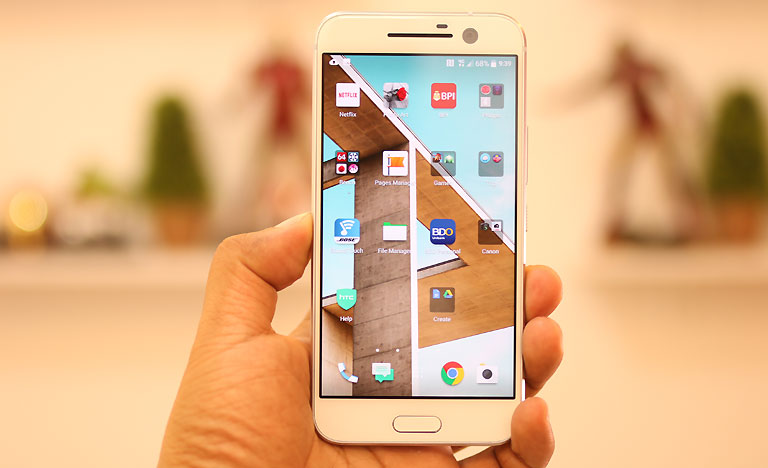
The dual front-facing speakers have been removed in favor of a more compact design. They redesigned BoomSound with one of the speakers up top along with the front-facing camera and the second speakers at the bottom end beside the USB charging port. That means you have one front-firing speakers and side-firing speakers that provide stereo sound that produces very loud output.
The more compact body also means better one-handed use while the thick chamfered edges offer a more comfortable grip. Up at the front is a physical home button that also serves as a fingerprint sensor. The scanner is actually very fast and responsive although the button itself is slightly recessed and there’s basically nothing to really press in there. Flanking the home button are two capacitive buttons for Back and Recent apps with backlights.
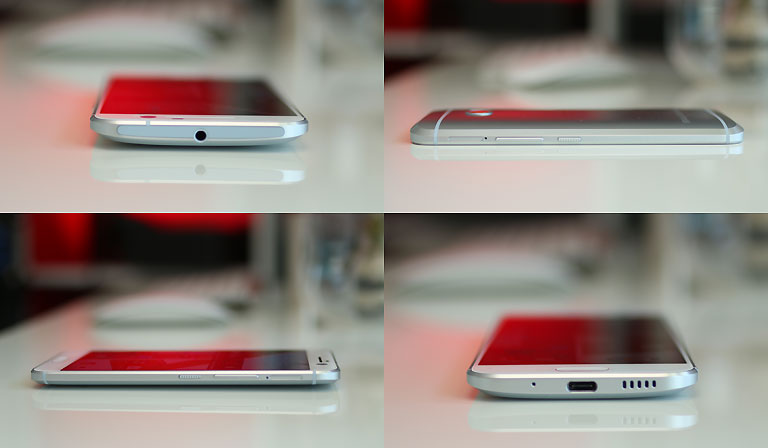
The volume controls and power button are on the right side. The power button has ridges along the top for better grip and easy identification even if you’re not looking at the device. The nano SIM card slot is just above it while the microSD card slot is on the opposite side which, by the way, HTC claims can support up to 2 terabytes of expandable storage.
Up top is the 3.5mm audio port in the middle of what could be a polycarbonate strip that is part of the antenna band. HTC has also removed the IR blaster which has been there since the first HTC One. At the bottom end is the USB Type-C charging port, the secondary loudspeaker and the microphone.

The back panel is curved with two antenna bands running across the top and bottom corners. Another noise-canceling mic is placed along the upper band. The rear camera is in the middle with the dual-LED flash and a laser autofocus on the right side.
Speaking of chamfered edges, the HTC went all out and peppered the HTC 10 with lots of them, large chunks all over the back side.
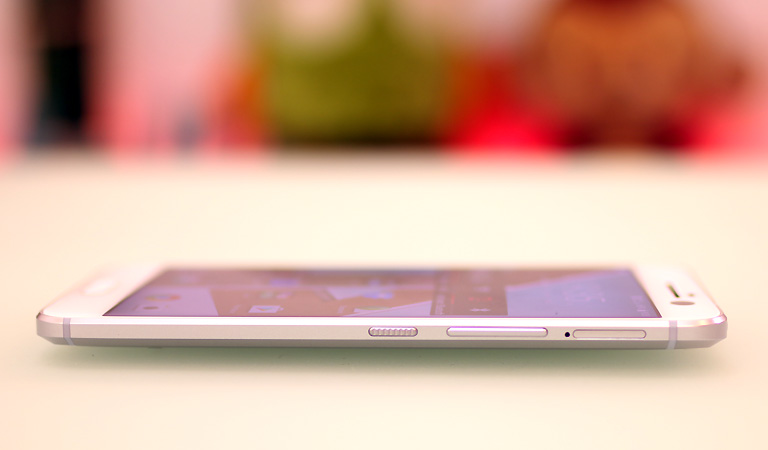
It’s a gorgeous device – simple and elegant up front, bold and masculine at the back. We only have one concern and that the finish is so slippery we often find it very hard to hold and operate the device with one hand. Perhaps a simple gel case would fix this problem.
Display
The display uses a quad HD Super LCD 5 which is HTC’s usual display technology in its flagship devices. It’s comparable to the usual IPS LCD panels and though not as rich or vibrant as AMOLED, it has its own advantages.

The entire front panel is covered with Gorilla Glass leaving a cut opening for the fingerprint scanner and front-firing speakers. The side bezels are narrow, about 2mm or thinner. The device is relatively compact with a relatively high 71% screen-to-body ratio.
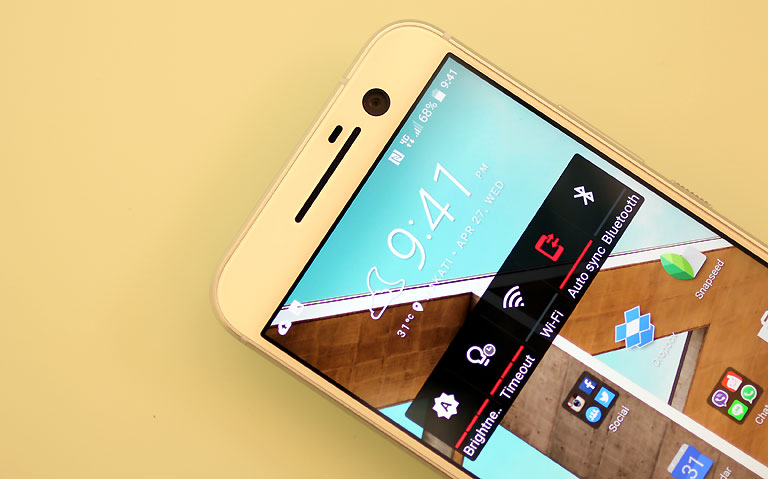
HTC packed 2560 x 144 pixels in a 5.2-inch with a 565 ppi pixel density. The display looks gorgeous and bright, colors are accurate and icons seem to pop out or float on the crisp display.
At 5.2 inches, the display size is just about right for web browsing and watching videos.
OS, Apps and UI
The HTC 10 came with Android 6.0.1 Marshmallow right out of the box along with HTC Sense UI 7.0 that adds some customizations on top of the plain Android interface.
Having experienced the HTC Sense from 5 years back, HTC actually pulled back on the customization and the interface is as close to the vanilla flavor as possible yet retaining that signature look with the icons, widgets and the layout. Blinkfeed is no longer a prominent feature but can still be enabled.
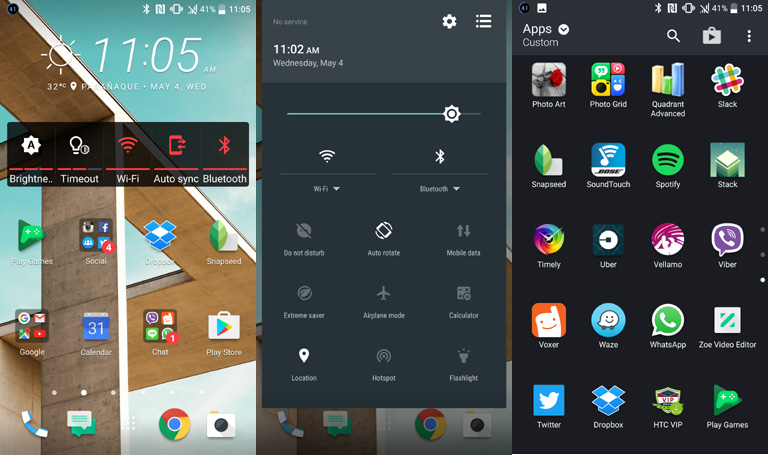
There are a few custom gestures that can be activated when the screen is off like double-tap to wake or sleep, swipe to unlock and double swipe to launch the camera app from sleep.
The pre-installed apps are as lean and mean so you no longer see two separate apps taking up screen space and storage. This usually happens when the vendor also includes its own native apps aside from the standard ones provided by Google Android – a separate browser from Chrome, a separate picture gallery from photo gallery, and another set of calculator and calendar apps from that of Android.
The HTC interface is clean and organized, the app drawer is straightforward and scrolls top-down with option for sorting the list of apps.
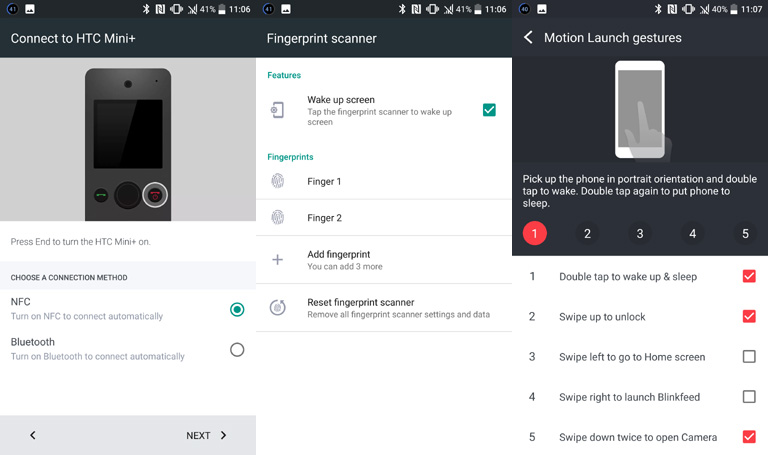
The HTC Mini+ feature still exists and if you still have that companion device from a couple of years back (we got one before for our HTC One M8, see review here), it will still be compatible with the HTC 10.
HTC uses TouchPal for the keyboard app and allows you to customize the look and layout of the keys to your liking, down to the size of the letters.
The capacitive keys that flank the physical home button can also be set to light up only when touched or fixed when the phone is in operation. The right capacitive button is set a Recent Apps by default (with one tap) or pull up Settings Menu when pressed longer. The left capacitive button just serves as a Back button.
Camera and Multimedia
HTC uses a rather meager 12-megapixel sensor in the rear camera. Though image quality is not determined by how megapixels a camera has, the 1.55um pixel size can result into better-looking photos.

Sensor size is a little above average at 1/2.3-type sensor but the wide-angle lens (26mm) means you can pack in more into a frame. This is good for scenic or panoramic shots.
Image quality is clean and crisp, color accuracy is spot on and white balance in pretty close to neutral. Some photos may end a bit over-exposed especially in very well-lit conditions (e.g. high noon) which is an effect of the high f1.8 aperture.
Autofocus is fast and accurate with pretty decent low-light performance. The Pro mode offers some manual controls but the exposure time is limited to just 2 seconds which isn’t enough if you want to take those really long exposure shots (the LG G4 and the LG V10 which can do up to 30 seconds).

Sample long exposure shot: f1.8, ISO 100, 2 sec.
Aperture is fixed at f1.8, ISO settings start at 100 up to 3200, shutter speed starts at 1/8000 right up to 2 seconds while White Balance ranges from 2300K to 7500K.
Here are some sample video clips:
The native camera app is pretty simple and straightforward. HTC Zoe is still there, a feature even Apple liked so much they included it in the latest iPhone 6s.
There is a shortcut to the camera apps from sleep/idle which requires two swipes from top to bottom of the screen. It’s not that intuitive or fast as the double tap on the home button for the Galaxy S7 but it’s an option to consider.
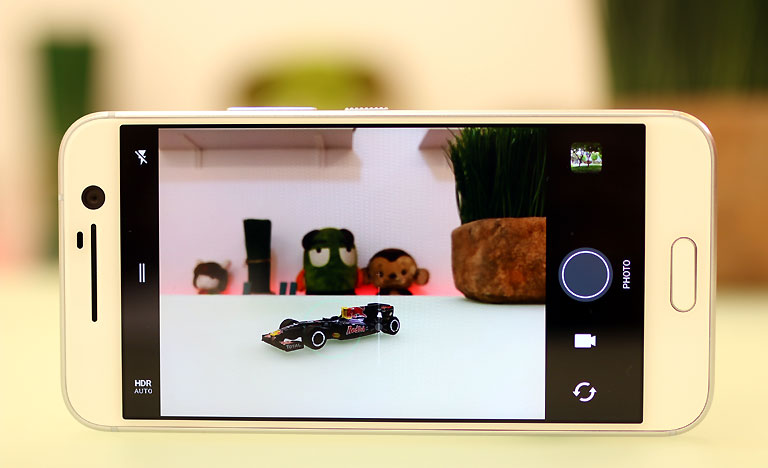
The rear camera is one of the best performaning camera we’ve used so far and could easily match the output of the Galaxy S7.
The HTC 10 is also the only smartphone that has a front-facing camera with built-in optical image stabilization (OIS) which should make for clearer selfies and less shaky video calls or livestreaming.
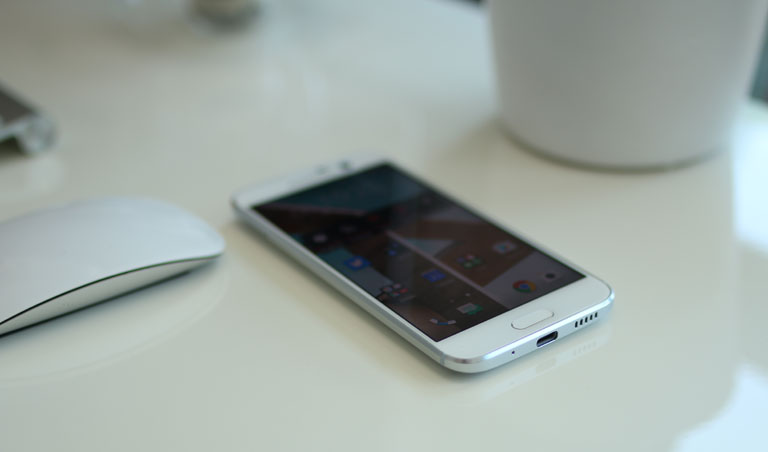
The loudspeakers are placed up front just beside the front-facing camera. This is the same placement as the BoomSound speakers of the previous HTC One devices. However, the second speakers are positioned at the bottom end beside the USB charging port. While the second one is no longer front-firing, both speakers are still really good and loud.
HTC dropped the IR Blaster which has long been a standard in previous HTC One devices. Perhaps they didn’t see a lot of people using it (though in our case, it’s one of the most frequently used feature) just like what Samsung did with the Galaxy S7.
Performance and Benchmarks
Powered by a Snapdragon 820 chip and 4GB of RAM, the HTC 10 is among the most powerful mobile devices in the market today only matched by the likes of the Galaxy S7, LG G5 and the Xiaomi Mi 5 Pro.
The device is snappy and responsive, loads up apps very quickly and can switch between dozens of apps with ease. The ability to multi-task efficiently is only limited by how many apps you can load up to the 4GB of on-board memory

Our benchmark tests showed impressive numbers with Antutu scores exceeding 138,000. The score matches or slightly edges out the ones we got from the Galaxy S7 and S7 Edge.
However, there are times that the device becomes uncomfortably warm during normal use that the processor throttles down resulting to a much lower benchmark scores (in the vicinity of 110,000).
The design and materials of the HTC 10 especially with the use of metal alloy at the back allows it to spread the heat generated by the processor more efficiently but that also means that the user will immediately feel that heat that sometimes could reach uncomfortable levels.
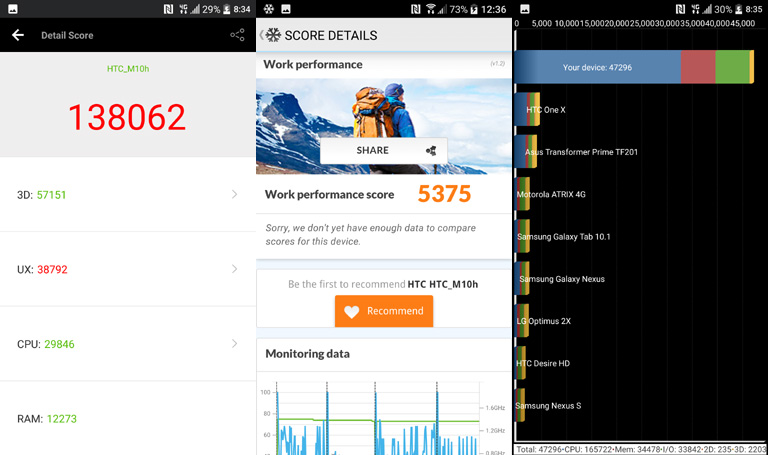
We’ve experienced this before with the HTC One M7 and though the HTC 10 exhibited similar behavior, it’s nowhere near the level of its predecessor.
Antutu Benchmark: 138,062
Quadrank Benchmark: 47,296
PC Mark Score: 5,375
Vellamo Scores: 3954 (Chrome), 2764 (Metal), 3251 (Multicore)
With the 4GB RAM, the HTC 10 can chew up pretty much anything we threw at it. The UI feels smooth and snappy, apps load quite fast, multi-tasking is a breeze and the over-all experience is just spot on.
Call Quality, Connectivity and Battery Life
The HTC 10 comes will all the connectivity options — fast dual-band WiFi and NFC, Bluetooth 4.2 and up to 13 supported LTE Cat. 9 bandswith promised data speeds of up to 450Mbps. Signal reception is strong, thanks to the integrated antenna bands, calls are loud and clear while sending/receiving text messages are quite fast.
There’s USB Type-C which is slowly becoming the standard.
The HTC 10 came with a 3,000mAh Li-Po battery which is pretty much just average these days for a lot of flagship devices we’ve tested (Galaxy S7, Zenfone 2).
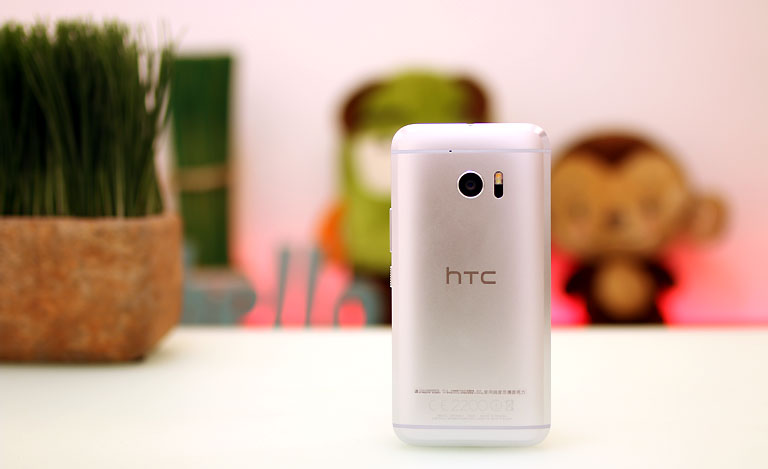
Using our PCMark Battery Life Test, the HTC 10 managed to eke out 8 hours and 19 minutes on a single full charge at 50% brightness and 0% volume. That’s almost the same as the Asus Zefone 2 Deluxe Edition (8 hours, 20 minutes) but a solid hour below the score of the Galaxy S7 (9 hours, 19 minutes). Even the older Galaxy S6 got better scores at 8 hours, 53 minutes. Our guess is that the Super LCD 5 display is not as efficient as AMOLED screens.
In our standard video loop test, the HTC 10 manage to last a full 9 hours and 45 minutes on a single full charge at 50% screen brightness and 0% volume.
With the Snapdragon chip, the Qualcomm’s Quick Charge 3.0 is supported on the HTC 10 which allows the device to re-charge in under 70 minutes. Unfortunately, wireless charging is not supproted.
Conclusion
The HTC 10 is, without a doubt, a beautifully crafted phone packaged with a impressive set of hardware. It’s a looker and we often get people very curious about it every time we fished it out of our pocket.

Yet, we find ourselves wanting a little bit more as if there’s something lacking or missing. We have come to a time that having the best design and best hardware seemed to be not enough. If there are a few things it lacks to really go against the Galaxy S7, that would be the IP68 waterproof feature and wireless charging.
All things considered, the HTC 10 is one excellent flagship device — handsome, well-rounded and a real workhorse.
HTC 10 specs:
5.2-inch QHD display @ 2560 x 1440 pixels, 565ppi
Super LCD 5
Qualcomm Snapdragon 820 processor 2.15GHz quad-core processor
4GB RAM
32GB, 64GB internal storage
up to 2TB via microSD
4G LTE Cat. 9
Bluetooth 4.2
WiFi 802.11 a/b/g/n/ac
NFC
12MP (HTC UltraPixel 2) rear camera w/ laser autofocus, OIS, f1.8 aperture (ultra wide-angle lens)
1.55um per pixel
5 MP, f/1.8, 23mm, OIS, autofocus, 1.34 µm pixel size, 1080p, HDR
HTC BoomSound Hi-Fi Edition
Dolby Audio
USB Type-C
Fingerprint sensor
GPS with aGPS, GLONASS
3000mAh battery
Android 6.0.1 with HTC Sense UI
Carbon Grey, Glacier Silver, Topaz Gold, and Camellia Red
What we liked about it:
* Great performance
* Very nice and bright display
* Good battery life
* Great sound quality from loudspeakers
* Impressive camera performance
What we did not like:
* A bit slippery on the hand
* Tends to warm up quite a bit

Apple, Asus, Cherry Mobile, Huawei, LG, Nokia, Oppo, Samsung, Sony, Vivo, Xiaomi, Lenovo, Infinix Mobile, Pocophone, Honor, iPhone, OnePlus, Tecno, Realme, HTC, Gionee, Kata, IQ00, Redmi, Razer, CloudFone, Motorola, Panasonic, TCL, Wiko
Best Android smartphones between PHP 20,000 - 25,000
Smartphones under PHP 10,000 in the Philippines
Smartphones under PHP 12K Philippines
Best smartphones for kids under PHP 7,000
Smartphones under PHP 15,000 in the Philippines
Best Android smartphones between PHP 15,000 - 20,000
Smartphones under PHP 20,000 in the Philippines
Most affordable 5G phones in the Philippines under PHP 20K
5G smartphones in the Philippines under PHP 16K
Sui Generisg says:
🌱 Noobs🏆1
Wala na bang purple tint issue ang cameras ng HTC? I used to like HTC designs a lot and their phones in general are good looking but the purple tint on the camera was such a let down.
Wired_boy says:
🥉 Rookie🏆1
hindi na daw
Ryan says:
🌱 Noobs🏆1
Magkano yan
[email protected] says:
🌱 Noobs🏆1
Hi. Compatible ba yung frequency nya sa 4G/LTE ng SMART or GLOBE ? Thanks
Abe Olandres says:
🥉 Rookie🏆3
Yes
newbie123 says:
🌱 Noobs🏆1
any idea po kung san maganda bumili ng HTC 10 since wala na silang physical shop dito?